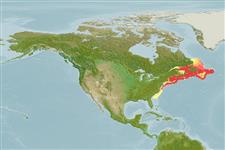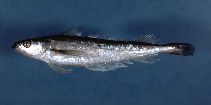Merluccius bilinearis (Mitchill, 1814)
Silver hake
Ajouter votre observation dans Fish Watcher
| Native range | All suitable habitat | Point map | Year 2050 |

|
| This map was computer-generated and has not yet been reviewed. |
| Merluccius bilinearis AquaMaps Data sources: GBIF OBIS |
Envoyez vos Photos et vidéos
Pictures | Sounds | Stamps, coins, misc. | Images GoogleMerluccius bilinearis
Picture by Flescher, D.
Pictures | Sounds | Stamps, coins, misc. | Images GoogleMerluccius bilinearis
Picture by Flescher, D.
Saint Pierre and Miquelon country information
Common names:
[No common name]
Occurrence: native
Salinity: marine
Abundance: | Ref:
Importance: | Ref:
Aquaculture: | Ref:
Regulations: | Ref:
Uses: no uses
Comments:
National Checklist:
Country Information: https://www.cia.gov/library/publications/resources/the-world-factbook/geos/sb.html
National Fisheries Authority:
Occurrences: Occurrences Point map
Main Ref: Simian, G., D. Abraham, N. Bailly, P. Béarez, F. Urtizberea, A. Perrot, H. Goraguer, R. Langlois, P. Daszkiewicz, F. Teletchea, S. Tercerie and G. Denys, 2022
National Database:
Occurrence: native
Salinity: marine
Abundance: | Ref:
Importance: | Ref:
Aquaculture: | Ref:
Regulations: | Ref:
Uses: no uses
Comments:
National Checklist:
Country Information: https://www.cia.gov/library/publications/resources/the-world-factbook/geos/sb.html
National Fisheries Authority:
Occurrences: Occurrences Point map
Main Ref: Simian, G., D. Abraham, N. Bailly, P. Béarez, F. Urtizberea, A. Perrot, H. Goraguer, R. Langlois, P. Daszkiewicz, F. Teletchea, S. Tercerie and G. Denys, 2022
National Database:
Common names from other countries
Classification / Names Noms communs | Synonymes | Catalog of Fishes(Genre, Espèce) | ITIS | CoL | WoRMS | Cloffa
> Gadiformes (Cods) > Merlucciidae (Merluccid hakes)
Etymology: Merluccius: Latin, mar, maris = the sea + Latin, lucius = pike (Ref. 45335).
More on author: Mitchill.
Etymology: Merluccius: Latin, mar, maris = the sea + Latin, lucius = pike (Ref. 45335).
More on author: Mitchill.
Environment: milieu / climate zone / depth range / distribution range Écologie
marin démersal; océanodrome (Ref. 51243); profondeur 55 - 914 m (Ref. 58452). Temperate; 55°N - 24°N, 80°W - 42°W (Ref. 54581)
Distribution Pays | Zones FAO | Écosystèmes | Occurrences | Point map | Introductions | Faunafri
Northwest Atlantic: coast of Canada and USA from Bell Isle Channel to the Bahamas; most common from southern Newfoundland to South Carolina.
Length at first maturity / Taille / Poids / Âge
Maturity: Lm 23.2 range ? - ? cm
Max length : 76.0 cm TL mâle / non sexé; (Ref. 1371); common length : 37.0 cm TL mâle / non sexé; (Ref. 1371); common length :65 cm TL (female); poids max. publié: 2.3 kg (Ref. 1371); âge max. reporté: 12 années (Ref. 1371)
Max length : 76.0 cm TL mâle / non sexé; (Ref. 1371); common length : 37.0 cm TL mâle / non sexé; (Ref. 1371); common length :65 cm TL (female); poids max. publié: 2.3 kg (Ref. 1371); âge max. reporté: 12 années (Ref. 1371)
Description synthétique Clés d'identification | Morphologie | Morphométrie
Épines dorsales (Total) : 1; Rayons mous dorsaux (Total) : 47 - 54; Épines anales: 0; Rayons mous anaux: 37 - 41. Head large, about 30% of SL . Pectoral fins long, reaching origin of anal fin. Overall color is silvery, somewhat brownish on back, whitish on belly.
Abundant on sandy grounds and strays into shallower waters. A voracious predator with cannibalistic habits. Individuals over 40 cm TL prey on fishes such as gadoids and herring, while smaller ones feed on crustaceans, i.e. euphausiids and pandalids; food also includes gaspereau, myctophids, smelt, silversides, mackerel, sand lance, butterfish, snakeblennies, longhorn sculpins and squids (Ref. 5951). The smallest specimen feeds mostly on crustaceans (Ref. 58452). Exhibits seasonal onshore-offshore migration (Ref. 9988). Spawning takes place from June-July in the mid-Atlantic region; July-August in the Gulf of Maine and to the north of Georges Bank, and August-September on the Scotian Shelf (Ref. 58452). Marketed fresh, smoked and frozen; fresh fish are exported to European markets; eaten fried, broiled, microwaved and baked (Ref. 9988).
Life cycle and mating behavior Maturité | Reproduction | Frai | Œufs | Fécondité | Larves
Spawning appears to be strongly influenced by water temperature, and annual variations occur both in the peak and the range of the spawning period, which may influence considerably the growth of juveniles.
Référence principale
Upload your references | Références | Coordinateur | Collaborateurs
Cohen, D.M., T. Inada, T. Iwamoto and N. Scialabba, 1990. FAO species catalogue. Vol. 10. Gadiform fishes of the world (Order Gadiformes). An annotated and illustrated catalogue of cods, hakes, grenadiers and other gadiform fishes known to date. FAO Fish. Synop. 125(10). Rome: FAO. 442 p. (Ref. 1371)
Statut dans la liste rouge de l'IUCN (Ref. 130435: Version 2024-2)
Quasi-menacé (NT) ; Date assessed: 06 January 2015
Menace pour l'homme
Harmless
Utilisations par l'homme
Pêcheries: hautement commercial; pêche sportive: oui
FAO(pêcheries: production, Résumé espèce; publication : search) | FishSource | Sea Around Us
Plus d'informations
Trophic ecology
Éléments du régime alimentaire
Composition du régime alimentaire
Consommation alimentaire
Food rations
Prédateurs
Éléments du régime alimentaire
Composition du régime alimentaire
Consommation alimentaire
Food rations
Prédateurs
Population dynamics
Paramètres de croissance
Max. ages / sizes
Length-weight rel.
Length-length rel.
Fréquences de longueurs
Mass conversion
Recrutement
Abondance
Paramètres de croissance
Max. ages / sizes
Length-weight rel.
Length-length rel.
Fréquences de longueurs
Mass conversion
Recrutement
Abondance
Life cycle
Reproduction
Maturité
Fécondité
Frai
Spawning aggregations
Œufs
Développement de l'œuf
Larves
Dynamique des populations larvaires
Reproduction
Maturité
Fécondité
Frai
Spawning aggregations
Œufs
Développement de l'œuf
Larves
Dynamique des populations larvaires
Anatomy
Surface branchiale
Brain
Otolith
Surface branchiale
Brain
Otolith
Physiology
Body composition
Nutrients
Consommation d'oxygène
Type de nage
Vitesse de nage
Visual pigments
Fish sound
Diseases & Parasites
Toxicity (LC50s)
Body composition
Nutrients
Consommation d'oxygène
Type de nage
Vitesse de nage
Visual pigments
Fish sound
Diseases & Parasites
Toxicity (LC50s)
Human related
Aquaculture systems
Profils d'aquaculture
Souches
Ciguatera cases
Stamps, coins, misc.
Aquaculture systems
Profils d'aquaculture
Souches
Ciguatera cases
Stamps, coins, misc.
Outils
E-book | Guide de terrain | Clés d'identification | Générateur de fréquences de longueur | Outil de dynamique de population | Carte par point | Classification Tree
| Catch-MSY |
Articles particuliers
Télécharger en XML
Sources Internet
Aquatic Commons | BHL | Cloffa | Websites from users | FishWatcher | CISTI | Catalog of Fishes(Genre, Espèce) | DiscoverLife | ECOTOX | Faunafri | Fishtrace | GenBank(génôme, nucléotide) | GloBI | GOBASE | GoMexSI (interaction data) | | Google Books | Google Scholar | Google | IGFA World Record | MitoFish | Otolith Atlas of Taiwan Fishes | PubMed | Reef Life Survey | Scirus | SeaLifeBase | Arbre de Vie | Wikipedia(aller à, chercher) | World Records Freshwater Fishing | Zoological Record
Estimates based on models
Preferred temperature (Ref. 115969): 0.9 - 7.8, mean 4.9 (based on 155 cells).
Phylogenetic diversity index (Ref. 82804): PD50 = 0.5000 [Uniqueness, from 0.5 = low to 2.0 = high].
Bayesian length-weight: a=0.00479 (0.00399 - 0.00575), b=3.11 (3.06 - 3.16), in cm Total Length, based on LWR estimates for this species (Ref. 93245).
Niveau trophique (Ref. 69278): 4.5 ±0.4 se; based on diet studies.
Résilience (Ref. 120179): Milieu, temps minimum de doublement de population : 1,4 à 4,4 années (K=0.18-0.4;tm=2-3; tmax=12).
Prior r = 0.26, 95% CL = 0.17 - 0.39, Based on 3 full stock assessments.
Fishing Vulnerability (Ref. 59153): Moderate to high vulnerability (54 of 100).
Climate Vulnerability (Ref. 125649): Moderate to high vulnerability (47 of 100).




